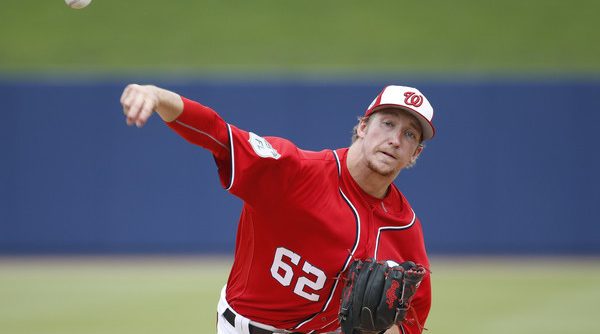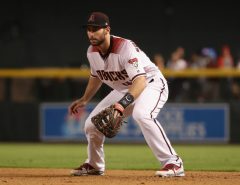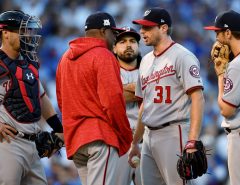If you’re reading this you already know that the Nationals bullpen has been bad; like really bad. Despite the the offense leading the MLB in nearly every major category, the bullpen (or lack thereof) has been the defining storyline of the Nationals 2017 season so far. I’m not going to beat a dead horse: We all know that the bullpen has been holding back what appears to be an all-time great Nationals offense and will continue to be a major issue as the season progresses. Finally, on Tuesday night, the front office took a drastic step towards fixing this problem; transitioning Erick Fedde, the organization’s top pitching prospect, out of the rotation and into a relief role.
While this move isn’t intended to be permanent, it’s still telling that the Nationals would rather risk the development of their top pitching prospect than trust any of their current depth options. This isn’t necessarily due to a lack of arms (Syracuse is chalk full of borderline major league relievers), but rather a lack of quality depth and the struggles of nearly every pitcher on the Syracuse staff. The Nationals’ AAA affiliate has somehow managed to be even worse than the big club on the mound, and currently the Chiefs only have two pitchers with an ERA under 4 (if you don’t count Brandon Snyder’s 0.00 ERA). Austin Adams has been excellent thus far but was recently placed on the 7-day DL and needs to control his walks before he can be counted on in the major leagues. Trevor Gott has been dominant in the month of May and has a track record of success in the majors, but likely isn’t the answer that the Nationals need right now. Joe Ross could be an option, but Mike Rizzo confirmed that he’ll be remaining as a starter, which is probably wise given that the 5th rotation spot has been a revolving door all season.
With a dearth of internal solutions and the skyrocketing price of relievers on the trade market, the front office is forced to get creative to solve the bullpen crisis, and thus we circle back to Erick Fedde. Fedde has been excellent so far in 2017, pitching to a 3.30 ERA over 7 starts and 1 relief appearance. His BABIP is a little low, his walks are up and his K’s are down, but overall the 24-year-old righty has impressed in his first full season at Harrisburg. Per Chelsea Janes of the Washington Post, the decision to move Fedde to the bullpen was backed by two main factors. Firstly, the front office hopes to keep the UNLV grad on an innings limit and secondly, of course, hope that he can contribute to the big club sooner rather than later. Fedde hit a career high in IP last season at 121, meaning he would ideally end up somewhere around 160 innings this season, which would likely preclude the talented righty from helping down the stretch if he remained in the Harrisburg rotation. By switching Fedde to the bullpen now, the Nationals are hoping to get as much value out of him as possible, and could even use his innings limit to their advantage by using Fedde in longer relief situations — similar to how the Astros use Chris Devenski.
Innings limit aside, the question of whether or not Fedde can even be an effective major league reliever still remains. Fedde has been successful at Double-A, but it remains to be seen whether or not his stuff will translate at the big-league level. At the moment Fedde’s arsenal consists of a sinking fastball that sits in the mid to low 90’s, a slider that has shown plus potential but can be inconsistent at times, and a mid 80’s changeup that will need improvement if Fedde hopes to reach his top of the rotation potential. For the sake of 2017, however, we’re going to put Fedde’s potential aside, and look at what he can provide the Nationals right now.
Far and away the best pitch in Fedde’s repertoire is his fastball, which he uses to generate ground balls at an over 50% clip. As I mentioned earlier the pitch usually sits in the low to mid 90s but in shorter stints should be able to play up into the mid 90’s with higher frequency. Fedde’s slider isn’t quite as polished as his heater, but scouts believe the pitch has plus potential, and it flashes this potential frequently. Fedde’s third and weakest pitch is his mid 80’s changeup which is still a work in progress, but should be good enough to supplement his otherwise excellent arsenal. As a reliever, Fedde will be able to rely much more heavily on his fastball and slider combo, as the need for a true third pitch will be much less important. Fedde’s fastball is already a major league ready pitch, and his slider flashes plus enough to generate swing and miss at the big league level despite its inconsistency. A sinking fastball in the mid 90’s and a biting slider is a deadly combination, and Fedde’s ability to generate ground balls and go multiple innings should make him a weapon out of the bullpen with experience.
Of course it’s easy to look at this move in a vacuum and understand why it was made, but Fedde is still the organization’s number one pitching prospect and a temporary move to the bullpen presents a sizable risk. While it is common for teams to use pitching prospects out of the ‘pen before putting them in the rotation, this is usually done later in the season, especially in September. It’s much less common for teams to rely on top prospects to bolster the pen, though it has been done before. Although he wasn’t a high end SP prospect, Blake Treinen spent nearly his entire minor league career as a starter, but was called up to pitch out of the pen when the Nationals needed a fresh arm in 2014. In that same year, Aaron Sanchez was called up by the Blue Jays to help an injury-riddled bullpen, and the very next year top pitching prospect Miguel Castro made the Jays roster out of Spring Training as a reliever. Similarly to Treinen, Nats fan favorite Jonathan Papelbon was called up in the midst of the Curt Schilling closer experiment when the Red sox badly needed effective relief pitching. These examples highlight the inherent value and risk associated with using top prospects out of the pen. Miguel Castro was ineffective in the majors, and was subsequently DFA’d due to injury. Treinen and Papelbon made starts in the MLB but were too valuable as relievers to return to the rotation. The most promising of the examples given is Sanchez, who was not only lights-out as a reliever but also successfully transitioned back to the rotation after two seasons in the pen.
It goes without saying that there is inherent risk in moving such a promising arm into the bullpen to fill an immediate need. We’ve seen pitchers flame out, get injured, or get stuck in bullpen purgatory. However there is a common thread between teams that take such a drastic step; they all have holes that need to be filled in their relief corps, and they almost always make the move with eyes on competing. Fedde may be a front-of-the-rotation arm in the future, but right now the Nationals need someone they can trust to take the ball and keep them in the game after the starters leave. With the Nationals offense firing on all cylinders, it would be foolish for the team to keep giving games away by not upgrading the bullpen. The move is a risk, but considering that the Nationals would likely have to trade Fedde to get a true bullpen upgrade anyway, I believe that the upside of Rizzo’s gamble is worth it.
Tags: Austin Adams, Erick Fedde, Joe Ross, Nationals, Nats, Trevor Gott, Washington Nationals




Here’s an off-the-wall suggestion. Subject the entire pitching staff to two psychiatric evaluations, one to determine suitability for relief work and the other to determine suitability for a starter’s role. It could well be that there are starters who should be in the bullpen and relief pitchers who could or should be starters. Ten to one says Max Scherzer would qualify with flying colors for both roles. He has undeniably the ability, the grit & determination & most importantly, the incredible self-confidence to get the job done, any job. I realize thoughts like these regarding Max are bordering on blasphemy, and the whole scenario probably indicates I should be the one to undergo psychiatric evaluation, but what the heck, the way things are going right now, what’s the harm.
What happened to my previous, well-thought out and articulate comment regarding the Nats relief pitching problems and suggested solution? Did it not pass muster and if so,can you advise me why for future reference? Thank you for your kind consideration.